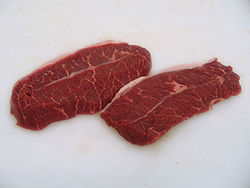 Beef Cuts | |
| Type | Chuck cut of beef |
|---|---|
| Part of a series on |
| Steak |
|---|
The beef top blade steak (also known as the chicken steak) comes from the chuck section of a steer or heifer.
 Beef Cuts | |
| Type | Chuck cut of beef |
|---|---|
| Part of a series on |
| Steak |
|---|
The beef top blade steak (also known as the chicken steak) comes from the chuck section of a steer or heifer.

The steaks are cross-cut from the top blade subprimal, the infraspinatus. [1] The same muscle cut with the grain gives flat iron steaks, which do not have the connective tissue (fascia) that runs down the middle of the blade steak.